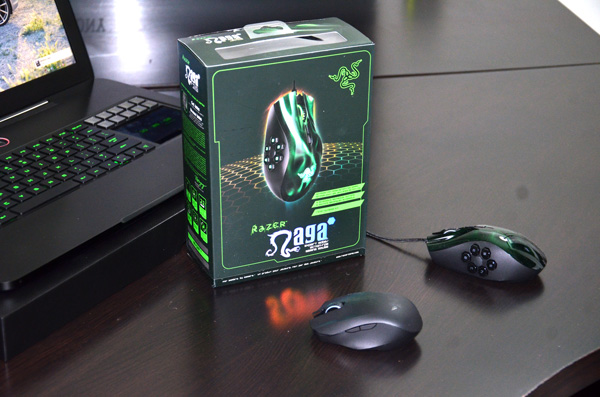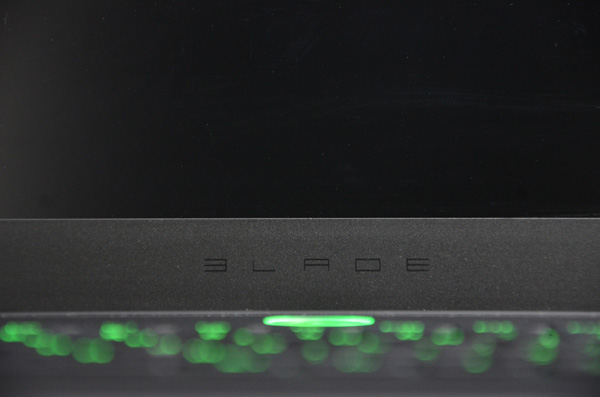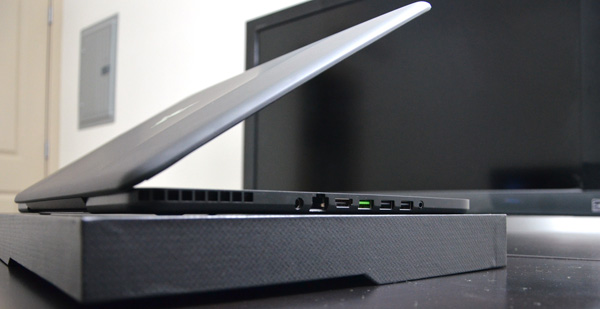The Razer Blade Review
by Vivek Gowri & Jarred Walton on March 15, 2012 3:01 AM ESTRazer is, first and foremost, a gaming company. From the company slogan (“By gamers, for gamers”), to partnerships with a number of the most popular game development studios, even the job title on the CEO’s business card (it reads Chief Gamer), nothing about Razer is shy about who the target market is. But it’s key to note that Razer is a gaming company which has focused on gaming-related peripherals and accessories—mice, keyboards, headsets, controllers, and limited edition peripherals for specific games. But that all changes as of now.
The vessel of change in question: Razer’s new Blade, a $2799 gaming laptop that bucks almost all of the common trends in gaming-focused desktop replacements. This isn’t the first time that Razer has shown intent to play in the gaming hardware space, having shown off the innovative Switchblade concept system at CES 2011. The Switchblade design concept clearly had a major influence on the Blade as is evident from the Switchblade UI panel on the side of the keyboard, but what’s important to note with the Blade is that it shows just how serious Razer is about transitioning into PC hardware and gaming systems. Read on to see how it fared.
| Razer Blade Specifications | |
| Processor |
Intel Core i7-2640M (2x2.80GHz + HTT, Turbo to 3.5GHz, 32nm, 4MB L3, 35W) |
| Chipset | Intel HM67 |
| Memory | 2x4GB DDR3-1333 |
| Graphics |
NVIDIA GeForce GT 555M 2GB GDDR5 (144 CUDA Cores, 675MHz/1350MHz/2.5GHz core/shader/memory clocks, 128-bit memory bus) |
| Display |
17.3" LED Matte 16:9 1080p AUO B173HW01 V5 |
| Hard Drive(s) | 256GB Lite-On LET-256M2S 6Gbps SSD |
| Optical Drive | - |
| Networking |
Intel Centrino Advanced-N 6230 802.11a/b/g/n Bluetooth 3.0 |
| Audio |
Realtek ALC275 HD Audio Stereo speakers Single combination mic/headphone jack |
| Battery | 6-Cell, 60Wh (integrated) |
| Front Side | - |
| Right Side | Kensington Lock |
| Left Side |
AC Adaptor Port Gigabit Ethernet HDMI USB 3.0 2 x USB 2.0 Headphone/Line-in Combo |
| Back Side | - |
| Operating System | Windows 7 Home Premium 64-bit SP1 |
| Dimensions |
16.81" x 10.90" x 0.88" (WxDxH) 427mm x 277mm x 22.4mm |
| Weight |
6.4 lbs 2.91kg |
| Extras |
2.0MP Webcam Ambient light sensor Backlit keyboard Switchblade UI Ten dynamic LCD keys 4.05" WVGA LCD touchpad (capacitive, multitouch) |
| Warranty | 1-year limited |
| Pricing | $2799 |
Heralded by Razer as the “World’s First True Gaming Laptop”, the 17” Blade is built around Intel’s Core i7-2640M and an NVIDIA GT 555M dGPU. The i7 is clocked at 2.8GHz, with a max turbo of 3.3GHz on two cores or 3.5GHz on a single core, while the GT 555M has 2GB of vRAM and clocks of 675/1350/2500 MHz for core, shaders, and vRAM, respectively. The GPU is pretty pedestrian by 17” gaming notebook standards, with the GT 555M falling somewhere between high-end mainstream and low-end gaming cards. There’s many different versions of the GT 555M, but the SKU in the Blade seems to be the most potent variant, using a cut down version of the same GF116 architecture in the GTX 560M. The rest of the specsheet is headlined by 8GB of memory and a 256GB SSD made by Lite-On. The Lite-On LET-256M2S is built around Marvell’s 88SS9174 controller, the same controller that serves as the basis for Intel’s SSD 510. Lite-On claims up to 480MB/s for sequential read and 330MB/s for sequential write speeds. The display is a 17.3” 1080p panel made by AU Optronics, but what we were most thrilled by is the beautiful matte screen finish. The Switchblade UI panel lives to the right of the keyboard and features 10 dynamic LCD keys (Art Lebdev-style) as well as a secondary display, a 4.05” 800x480 multitouch LCD that serves as the Blade’s touchpad. In addition, Razer includes a special edition of their Bluetooth mobile gaming mouse, the Orochi.
Rather impressively, Razer managed to pack all that hardware into an enclosure that’s just 0.88” thick and weighs 6.4lbs. If Intel were to extend the ultrabook hardware guidelines out to 17” notebooks, the Blade would hit them pretty dead on. The razor-thin (get it, get it?) profile explains why Razer was limited to a GT 555M—simply put, Razer couldn’t fit anything more powerful into the thermal design without significantly compromising the performance of the cooling system. But what’s noteworthy here is that Razer took the design of the Blade in completely the opposite direction of the majority of the gaming notebook world.
If you were to poll a large group of people for the best 17-18” gaming class portable on the market, you’d end up with a range of answers—Alienware’s M17x or M18x, the ASUS G74Sx, some variant of Clevo’s P170HM, possibly the MSI GT780, etc.
| Razer Blade | Alienware M17x R3 | Alienware M18x | ASUS G74SX | Clevo P170HM | MSI GT780-DXR | |
| CPU | Core i7-2640M | Core i7-2670QM | Core i7-2670QM | Core i7-2670QM | Core i7-2670QM | Core i7-2670QM |
| GPU | GT 555M | HD 6990 | GTX 560M SLI | GTX 560M | GTX 580M | GTX 570M |
| Thickness | 0.88" | 1.76" | 2.13" | 0.82-2.44" | 1.65-1.89" | 2.17" |
| Weight | 6.40lbs | 9.39lbs | 11.93lbs | 9.42lbs | 8.60lbs | 8.63lbs |
| Price | $2799 | $2049 | $2899 | $1399 | $2239 | $1699 |
Take a look at the spec table—the Blade is thinner than everything up there by at least a factor of two, as well as being at least two pounds lighter. It’s also a good deal more expensive than everything but the M18x, and a good deal less powerful. (It's worth noting that the Blade is the only one on the list with an SSD, but otherwise they're pretty similar—1080p, 8-12GB memory, etc. Factor an additional $200 to upgrade to an SSD in the other systems.) Comparing the M18x and the Blade head to head is a bit of comedy—in terms of form factor, the Blade is literally half the laptop the nearly twelve-pound M18x is. They’re both very high-end and very expensive gaming notebooks, but they couldn’t be any more different after that.
So it’s pretty clear that Razer wasn’t aiming at the gaming notebook establishment—in fact, on paper the Blade looks a bit like the Windows answer to the 17” MacBook Pro. Which isn’t to say that the 17” MBP is a competitor for the Blade in any way—the design ethos and target markets are completely different, but it’s worth noting the similarities in form factor and price, as well as the focus on premium design and overall attention to detail. In the PC world, the closest you’re going to get on paper is the HP ENVY 17, at 1.28” thick, 7.37lbs, and starting at $1249 with AMD Radeon HD 7690 XT graphics.
Where I’m going with all this is to show that the Blade is a pretty unique proposition in the notebook world—it’s a high-end 17” gaming portable that, at least in terms of hardware, focuses more on the portable than the gaming.













95 Comments
View All Comments
geniekid - Thursday, March 15, 2012 - link
I will echo the general sentiment that this thing is both overpriced and inadequate for gaming, but at the same time it's nice to see a company really try and increase the overall build quality of a laptop.The problem is when you take big risks like this you have to get it right the first time, or you have to have enough resources in reserve (and enough faith from the powers on high) to iteratively improve the product until it's good enough. I hope Razer gets into the latter category and succeeds.
kenyee - Thursday, March 15, 2012 - link
Cost unfortunately is too high. And what's with only 2 memory slots on a giant 17" laptop?The rest actually looks pretty cool. If Apple released something like this, their fanboys would be all over it, despite the price ;-)
Hopefully high res displays will drop in price and ivy bridge/kepler will make this a lot more interesting...
Felix_Ram - Thursday, March 15, 2012 - link
I can't help but think that Razer is out too early on the market, and that they have the wrong cpu company in their machine. Their concept is good, it's just not competitive enough.If they were launched with the coming AMD APU, the topline trinity, and they at the same time managed to crossfire the APU with an AMD GPU, without changing the machines design, they might have a much more competitive product on their hand.
JarredWalton - Thursday, March 15, 2012 - link
No way. Trinity very likely won't even be as fast as Sandy Bridge for CPU tasks, the APU graphics won't be as fast as a GT 555M by a long shot (about 33% slower I'd wager, though I could be wrong), and AMD's switchable graphics and dual graphics still has serious driver issues in my experience. You don't spend basically $1500 on the industrial design and build quality only to ship it with a slower CPU and GPU.VivekGowri - Friday, March 16, 2012 - link
Agree with the "too early to market", disagree with everything else. If they had waited a couple of months, this could have Ivy Bridge and Kepler, and they could have used the extra month or two to fix some of the more pressing stability issues that plagued Switchblade at launch. It's a bit of a pity that they didn't, actually.tonyn84 - Thursday, March 15, 2012 - link
I really, really like the form factor of this, I think moving the trackpad to the right side is brilliant (sorry lefties) and really hope to see this in future gaming laptops. The price though, I can't even get close to justifying for the performance. With any luck though they'll be able to have a couple different models at some point after ivy bridge is available. If they can get is closer to $1500 I'd seriously consider it, even with slightly less bells and whistles.Bees - Thursday, March 15, 2012 - link
What I'd like to know is why the facts that the keyboard and touchpad can both go unresponsive on their own wasn't treated in this review like the showstopping bugs they are. I've seen it firsthand with someone else's Blade, it's ridiculous that something so widespread (according to the support staff on the phone) made it past QC on such an expensive piece of tech.JarredWalton - Thursday, March 15, 2012 - link
I don't know if Vivek ever had this happen, but I certainly didn't encounter that problem in the several days of testing I did. Most likely it is a QC bug and your friend got bit, or else something else is going on. That said, I do not like the keyboard or touchpad at all. Vivek had more time to adapt so I left that to him to discuss, but I found the touchpad to be an expensive gimmick.IKeelU - Thursday, March 15, 2012 - link
Finally a company willing to invest in portability, good design and quality, that isn't called Apple. I would buy this without even thinking of it as a gaming laptop, if only they could reduce the noise level.Considering how many actually spend 2k+ on Macbooks, I'm astonished that it took a peripheral company to invent such a desirable high-end laptop. I hope this sells well, and I hope Dell, HP et al. take note.
FormulaRedline - Thursday, March 15, 2012 - link
This product is an early April fools joke, right? I saw "Gaming" and "1080p" followed shortly by "555m" and basically stopped reading. That is until I saw the almost $3k price tag...then I had to post.You can pretend Marketing screwed this up by claiming it to be a top of the line gaming product when it's really more a 17" ultrbook/MPB -like machine, but Razer is SUPPOSED to be high end gaming. 555m's belong in sub-$1000 machines that can do some gaming on the side at lower resolutions.
Meanwhile, it's got a great processor. Oh good, now we can bottleneck the @#*$ out of it. Has anyone at Razer ever even built a computer?